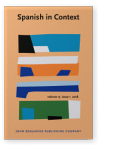Y luego se pintan patrás…
Metaphorical extension and the grammaticalization of patrás in Nuevomexicano Spanish
The expanded use of patrás is among the most salient features of US Spanish and commonly attributed to English influence. For Lipski (1986), it constitutes a syntactic calque from English constructions with back; Otheguy (1999) maintains it shows cultural but not linguistic influence; Villa (2005, 2010) ascribes patrás to grammaticalization processes internal to Spanish. Previous studies lack a detailed account of the semantics of the spatial adverbial in its historical and contemporary usage. Applying Talmy’s (1983) typology of motion events to corpus data, this paper traces a grammaticalization path for patrás from its historical use to its contemporary use in Nuevomexicano Spanish. Patrás has shifted from primarily atelic backwards motion meanings to primarily telic return meanings. This shift is evident across Germanic languages for adverbs deriving from the noun back and in the Romance prefix re- from Latin adverb retro. This study proposes contact with English led to an increased frequency of satellite-framed constructions in Nuevomexicano Spanish, creating the frequency conditions for innovations in the form and meaning of para atrás to conventionalize and lead to systematic linguistic change.
Article outline
- 1.Background
- 2.Present study
- 3.The semantics of space and metaphor
- 4.
Para atrás and para tras in historical varieties of Spanish 1494–1900
- 4.1Backwards movement
- 4.2Location in an area behind the Ground
- 4.3Orientation towards a site behind the Ground
- 4.4Reverse movement along a path already followed
- 5.
Patrás in contemporary Nuevomexicano Spanish
- 5.1Return through physical space
- 5.2Return through metaphorical space
- 5.3Reciprocal exchange of acts of communication
- 5.4Continued use with older meanings
- 6.The changes to patrás: Metaphorical extension and grammaticalization
- 7.Conclusions
- Acknowledgements
- Notes
-
References
References
Alcón, Manuel
2005 Lo de Mora. Victoria, B.C.: Trafford Publishing.

Bybee, Joan
2010 Language, Usage and Cognition (1st edition). Cambridge ; New York: Cambridge University Press.


Bybee, Joan, & Pagliuca, William
1985 Crosslinguistic comparison and the development of grammatical meaning. In
Historical Semantics Historical WordFormation ed. by
Jacek Fisiak, 59–83. Berlin: Walter de Gruyter.


Croft, William
2001 Radical Construction Grammar. New York: Oxford.

Davies, Mark
2002-
Corpus del Español: 100 million words, 1200s–1900s. Available online at
[URL].
Espinosa, Aurelio M.
1911 The Spanish language in New Mexico and southern Colorado. Santa Fe, N.M: New Mexican Print. Co.

Espinosa, Aurelio M.
1914 “
Studies in New Mexican Spanish, Part III: The English elements.”
Revue de Dialectologie Romane 61: 241–317.

Espinosa, Aurelio M.
1917 Speech mixture in New Mexico: the influence of the English language on New Mexican Spanish (pp. 99–114). Macmillan.

Fillmore, Charles J.
1966 “
Deictic Categories in the Semantics of “Come”.”
Foundations of Language 2 (3): 219–227.

Gibbs, Raymond W.
1998 “
The fight over metaphor in thought and language.”
Figurative language and thought: 88–118.

Hills, Elijah C.
1906 “
New-Mexican Spanish.”
PMLA: Publications of the Modern Language Association of America 21 (3): 706–53.


Himmelmann, Nikolaus P.
2004 “
Lexicalization and grammaticization: Opposite or orthogonal.”
What makes grammaticalization: 21–42.

Lara, Luis. F.
(
2011)
Diccionario del español de México. Volumen 21. El Colegio de Mexico AC.

Lakoff, George, & Johnson, Mark
1980 Metaphors we live by.
University of Chicago (Revised edition 2008)

Lehman, Christian
1985 “
Grammaticalization: Synchronic variation and diachronic change.”
Lingua e Stile 201: 303–318.

Lipski, John M.
1986 “
The construction pa(ra) atrás among Spanish-English bilinguals: parallel structures and universal patterns.”
Revista Iberoamericana 28–291: 87–96.

Otheguy, Ricardo
1999 “
A reconsideration of the notion of loan translation in the analysis of US Spanish.” In
Spanish in the United States: Linguistic contact and diversity ed. By
A. Roca and
J. Lipski, 21/45. Berlin: Walter de Gruyter.

Radden, Günter
2004 The metaphor TIME AS SPACE across languages. na. Retrieved from
[URL]
Talmy, Leonard
1983 “
How Language Structures Space.” In
Spatial Orientation ed. by
H. L. P. Jr &
L. P. Acredolo, 225–282. Springer US. Retrieved from
[URL] doi:

Talmy, Leonard
2000 Toward a cognitive semantics, Vol. 1: Concept structuring systems. Cambridghe, Mass.: The MIT Press.

Villa, Daniel. J.
2005 “
Back to Patrás: A Process of Grammaticization in a Contact Variety of Spanish.” In
Proceedings of the 4th International Symposium on Bilingualism ed. by
J. Cohen,
K. T. McAlister,
K. Rolstadt &
J. MacSwan, 2310–2316.

Villa, Daniel J.
2010 “
Y nos vamos patrás: Back to an analysis of a supposed ‘calque’.” In
Spanish of the U.S. Southwest: A Language in Transition ed. by
S. V. Rivera-Mills and
D. J. Villa, 239–251. Madrid/Frankfurt: Iberoamericana/Vervuert..


Cited by
Cited by 3 other publications
Lease, Sarah
2023.
A usage-based account of paragogic /e/ in 20th century New Mexican Spanish.
Studies in Hispanic and Lusophone Linguistics 16:2
► pp. 473 ff.

Ramírez Urbaneja, Desirée
2020.
“¿Tú tienes unalittle pumpkin?” Mixed noun phrases in Spanish-English bilingual children and adults.
International Journal of Bilingualism 24:4
► pp. 824 ff.

This list is based on CrossRef data as of 13 april 2024. Please note that it may not be complete. Sources presented here have been supplied by the respective publishers.
Any errors therein should be reported to them.
